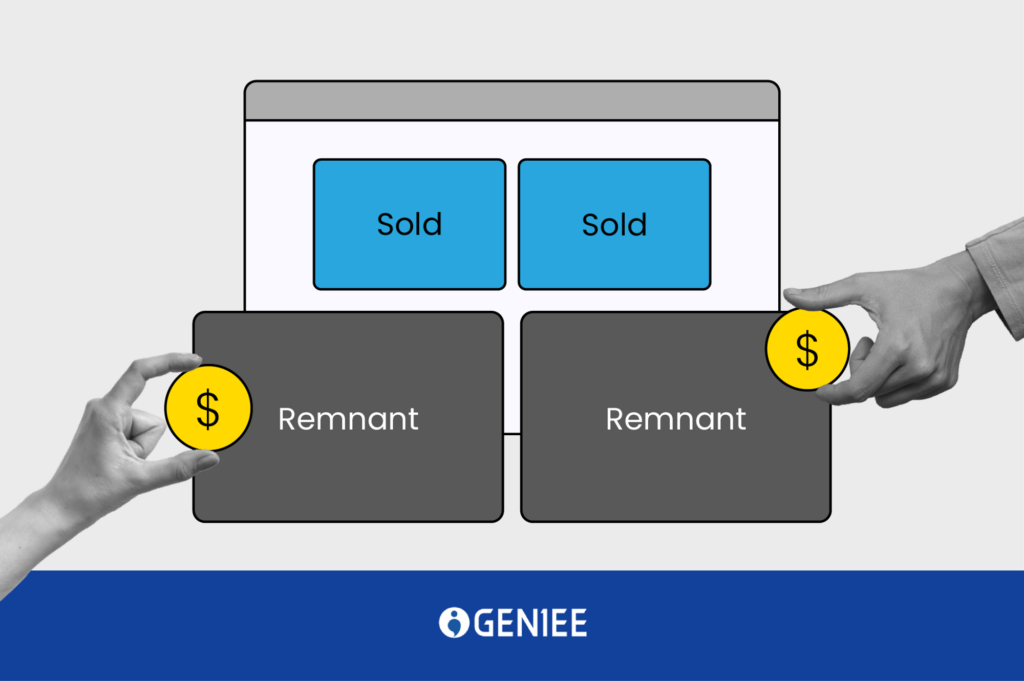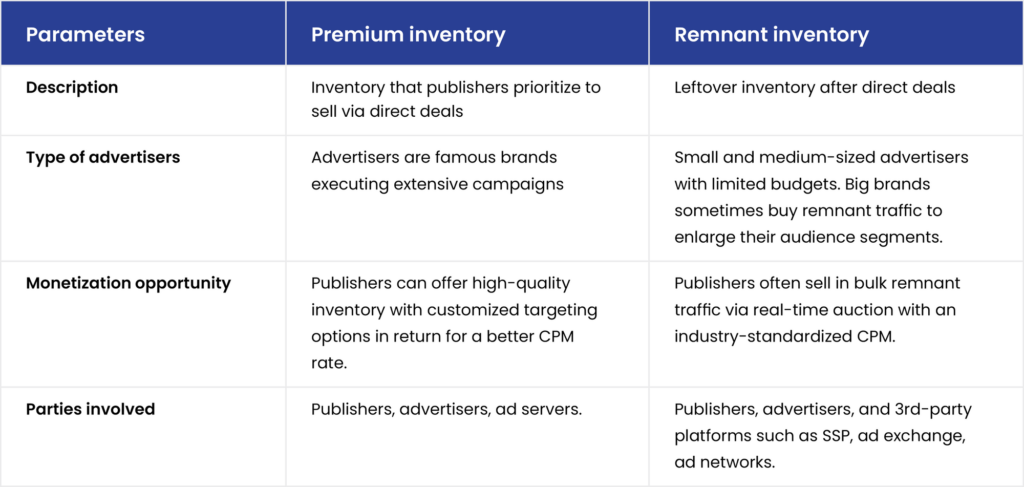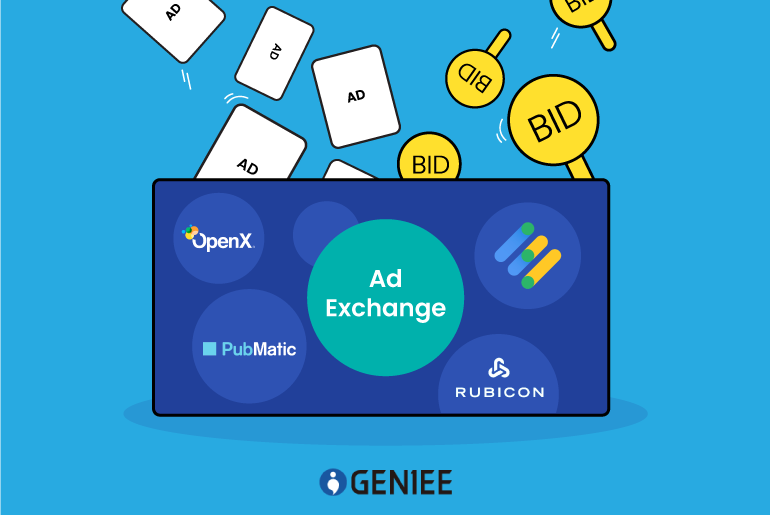
The term remnant inventory might sound familiar to those who have been working in digital advertising for many years. How about the new ones?
Have you ever encountered the issue of unsold ad space in the online advertising realm?
It’s a common challenge within the digital advertising industry, and managing these vacancies can significantly impact your revenue stream. In this blog, we’ll explore the best strategies for effectively optimizing the utilization of unsold ad space to maximize revenue.
What is Remnant Inventory?
Remnant inventory is the leftover or unsold ad inventory publishers have available after selling their premium or high-value ad placements. To be more specific, this unsold ad inventory consists of digital ad placements that have yet to be filled by direct sales. Some other terms you might hear about are “remnant traffic” or “unsold traffic”.
Let’s examine the following example.
A popular lifestyle blog has a massive number of monthly visits. It sells premium inventory on its homepage, expecting to sell 2,000,000 ad impressions. However, with specific targeting from advertisers’ marketing campaigns, it sells only 1,500,000 of these impressions, leaving 500,000 unsold ad impressions (remnant inventory).
To monetize these impressions, the blog partners with an ad network, filling them with relevant ads like lifestyle apps or travel accessories. This ensures that all available inventory contributes to the blog’s revenue stream.
Likewise, all publishers aim to monetize every impression, though some could be sold at a lower price. This is when effectively managing remnant inventory becomes all-important.
Remnant inventory holds its own unique value despite it may have lower visibility and engagement rates or be less targeted compared to premium inventory. Publishers frequently seek to monetize remnant traffic by selling it at discounted rates through ad networks, exchanges, or other programmatic advertising platforms.
What is Premium Inventory?
Premium inventory, or premium traffic, refers to the highest-engaged ad placements on the publisher’s website and is sold at a high price. Premium inventory often comprises ad spaces on the homepage, above-the-fold placements, or within highly relevant and targeted content sections.
Advertisers are willing to pay a premium price for these placements due to their strategic positioning and the quality of the audience they reach. The revenue from premium inventory, hence, takes a significant portion of publishers’ advertising revenue.
Let’s check the table below to see the difference between premium and remnant inventory.

Why Remnant Inventory show up?
If premium inventory is so beneficial to publishers, then why is there still a lot of remnant traffic? There are 4 main reasons as follows:
- Only a chunk of traffic meeting the advertisers’ targeting requirements can be sold at a high price.
- More premium inventory yet less demand.
- Market’s seasonal trends when brands don’t run extensive campaigns.
- Ineffective ad setup.
Best Practices to Effectively Manage Remnant Inventory
Monetizing unsold ad space can be tricky for publishers.
Just because an impression doesn’t meet the criteria of your premium deal doesn’t mean it’s “valueless”. There’s a high likelihood that advertisers are actively seeking such impressions and willing to pay a competitive price for them.
Here are some best practices to guide you on how to optimize your remnant inventory.
Partner with multiple demand partners
Increasing demand enhances competitiveness in ad auctions. Hence, it’s beneficial for publishers to collaborate with multiple demand partners, evaluating their performance and switching if necessary. In addition, connecting with partners who are capable of handling various ad types, such as banner ads, video ads, and native ads, will bring in a better monetization strategy.
Implement header bidding
Header bidding uses RTB auctions, which allows bids to be sent simultaneously to multiple bidders. With control over bidder selection, publishers can improve demand quality, leading to better yield.
Utilize preferred deals
This option allows publishers to maximize impression revenues before bringing them to the open market. By offering advertisers the opportunity to purchase inventory at a pre-negotiated fixed price, publishers can secure better rates compared to real-time bidding, thus enhancing yield from remnant inventory.
Enable targeting
Advertisers prefer targeted impressions for campaign relevance despite buying remnant traffic. Enabling targeting for ad units enhances impressions’ value, especially ones with good viewability scores. However, publishers should remember to ensure compliance with privacy regulations by obtaining user consent for targeted ads.
Implement fallbacks
In instances where real-time auctions fail to fill impressions, setting up fallbacks for unfilled impressions minimizes loss. Unfilled impressions can be utilized for self-promotion, such as banners for upcoming webinars or new product launches, ensuring optimal inventory utilization.
Choose selling models wisely
As the website gets more traffic, monetizing from display advertising is no longer the only way to earn money. Publishers might think of other methods, like email newsletter ads or affiliate links. Each strategy requires a tailored monetization model, such as CPM for display advertising and CPA for affiliate ads. Publishers should carefully align the selling model with buyer preferences for optimal results.
Tips to increase fill rate for remnant inventory
Audience segmentation
Segmenting your inventory can expedite sales compared to non-segmented inventory. Advertisers, even in real-time bidding scenarios, seek insight into the audience they’re reaching. Segmented inventory provides this clarity by conveying general user attributes, making it more appealing to advertisers.
Price floor optimization
Price floors are crucial in balancing profitability and fill rate. Setting them too low may invite ad fraud while setting them too high can lead to unfilled impressions. Continuous monitoring and adjustment of price floors are necessary to strike the right balance, ensuring optimum profitability and fill rate.
How to Choose Relevant Demand for Remnant Inventory?
If you find that despite having healthy traffic with a good viewability score, a significant portion of your inventory remains unfilled, your demand pool is likely too small. In such a case, expanding and optimizing your network of demand partners becomes essential.
Here are some tips to assist you in finding relevant demand partners for your remnant inventory.
Analyze Audience Segmentation
Understand your audience’s demographics, interests, and behaviors. Segment your remnant inventory based on these insights to attract demand partners seeking specific audience characteristics. For example, if your audience predominantly consists of tech enthusiasts, prioritize demand partners specializing in technology-related advertising.
Evaluate Demand Partner Specializations
Research and evaluate demand partners based on their expertise and specialization. Look for partners with a track record of success in your niche or industry vertical. Consider demand partners offering solutions tailored to your audience segments, such as mobile advertising specialists or video ad networks.
More to discover
All About Video Ads: Formats, Setup & Benefits for Publishers

Consider Ad Quality and Relevance
Ensure that demand partners deliver high-quality ads that align with your website’s content and audience preferences. Avoid partnering with demand sources that may compromise user experience with intrusive or irrelevant ads. Prioritize partners offering contextual targeting options to serve ads that resonate with your audience’s interests and preferences.
Monitor and Optimize Performance
Continuously monitor the performance of demand partners and remnant inventory. Track key performance metrics such as fill rates, eCPM (effective cost per mille), and revenue generated. Based on performance insights, optimize partnerships, adjust inventory allocation, and prioritize top-performing demand sources.
Conclusion
Remnant inventory could play a big part in a publisher’s advertising revenue stream. However, this requires effective management to reach the maximum potential and fill rate. If you need any consultation, leave a comment below or contact us for a better ad monetization model.

0 Comments